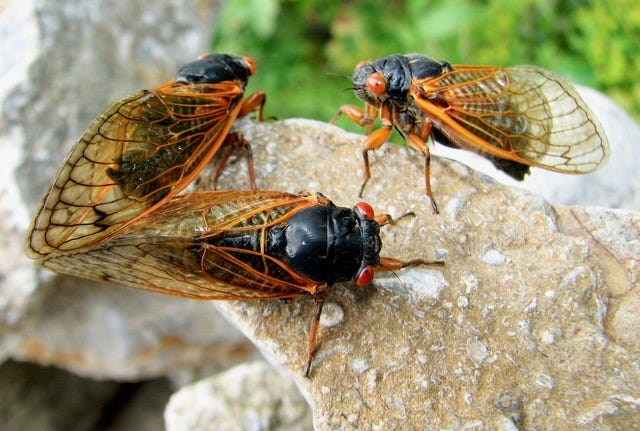Brood XIV, the latest group of buzzing cicadas, is emerging this spring. This time, billions of the insects will hit at least 12 states, experts say.
This brood is considered the second-largest periodical cicada brood, according to the University of Connecticut.
Brood XIV is one of 15 broods of periodical cicadas that emerge every 13 or 17 years, reported the Cincinnati Enquirer, part of the USA TODAY network.
They come out of the ground when soil temperatures reach 64 degrees. While annual cicadas emerge worldwide each year, periodical cicadas can be found only in the eastern United States, the Enquirer reported.
Brood XIV: See the 2025 cicada map
Based on past behaviors, the group is likely making its appearance in Georgia, Kentucky, Maryland, Massachusetts, New Jersey, New York, North Carolina, Ohio, Pennsylvania, South Carolina, Tennessee, Virginia and West Virginia, and in nine southern counties in Indiana, said Gene Kritsky, founder of Cicada Safari, a group that gathers data on the insects.
This map shows roughly where Brood XIV is expected to appear this spring. However, experts say it can be tricky to know exactly which counties will have confirmed sightings.
Set to garden or go hiking in Delaware? Here’s how to identify poison ivy, oak, sumac
Spotted lanternfly season is here: Here’s what you need to know
Delaware hummingbird tracker 2025: Here are locations these cute birds visited
Why it’s hard to know exactly where broods will emerge
John Cooley, an associate professor in residence in the ecology and evolutionary biology department at the University of Connecticut, previously told USA TODAY that researchers determine where cicadas will emerge using past records. The university also has a map logging verified sightings of Brood XIV cicadas.
However, it’s not so cut-and-dry when determining where certain broods will be.
According to Cooley, sometimes broods get their wires crossed and end up emerging during off-cycles. Cicadas may emerge this spring in areas such as New York; Washington, D.C.; Maryland; and South Carolina, but it doesn’t mean they’re part of Brood XIV, Cooley said.
What’s known for sure, he said, is that in Massachusetts, Brood XIV will emerge in a small part of Cape Cod, in New York, Brood XIV will emerge on a small part of Long Island, and in Indiana, the brood will be in the southern part of the state, west of Louisville.
“There’s a bit of confusion … in southern Ohio around Cincinnati,” Cooley said. “There’s quite a lot of off-cycle emergence, such that broods may be displacing each other.”
Deborah Waller is an associate professor of biological sciences at Old Dominion University. Referring to Cooley’s previous work, she said that older emergences occurred on the state line but not within the state of South Carolina.
“There was an emergence at the southern border of Indiana but no emergence in D.C.,” she said. “It is likely that the 2025 emergence of Brood XIV will follow the GPS-based map of 2008.”
How often do these cicadas appear?
Brood XIV emerges every 17 years, so the last time they emerged was 2008, said Kritsky. Brood XIV probably will begin to emerge during the third week of April, or when areas get a “good rain,” Kritsky previously told USA TODAY.
Cicadas from Brood XIV, taken in 2008. The insects emerge every 17 years.
According to Kritsky, this is the order in which they’ll likely emerge:
-
Third week of April – northern Georgia
-
Fourth week of April – southern Tennessee and South Carolina
-
First week of May – central Ohio, northern Tennessee, western Virginia
-
Second or third week of May – West Virginia, northern Kentucky, southern Ohio, Maryland and Massachusetts
Cooley, from the University of Connecticut, previously said Kentucky and Tennessee will likely see the most cicadas this year. Other states with large numbers of cicadas will be Georgia, the Carolinas and Pennsylvania, he said.
What’s the life cycle of a cicada?
Cicadas are part of the hemiptera order, the same group that includes stink bugs, bed bugs, aphids and cicada families, Kritsky said. Periodical cicadas like Brood XIV only occur in the eastern half of the U.S., he said.
The insects in this brood spend years underground, emerging every 17 years. They are known for the buzzing sound the males make. The males sing three different types of songs and duet with the females before mating, said Cooley from the University of Connecticut.
Once they mate, the females lay eggs in tree branches. Around 6 to 10 weeks later, the eggs hatch and the babies drop to the ground, said Kritsky. The juveniles then go beneath the ground and feed on grass roots.
Contributing: Chad Murphy, The Cincinnati Enquirer
Saleen Martin is a reporter on USA TODAY’s NOW team. She is from Norfolk, Virginia – the 757. Email her at [email protected].
This article originally appeared on USA TODAY: Cicada Brood XIV to emerge in at least a dozen states: See map
Read the full article here
